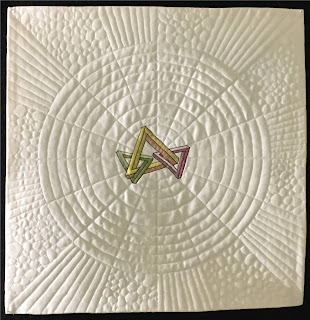It was my goal to put the Penrose triangle on a quilted background that is mathematically divided by circles and lines. As you can see by my drawing, my plan was to interlock the Penrose triangles across the quilt.
I printed the triangles on Transfer Artist Paper (TAP) and then colored them with Tsukineko inks. The transfer of the triangles did not work and I suspect it was because my TAP was more than a year old.
However, not to be defeated, I managed to get a few to print onto Chiffon and then I machine appliqued them onto to back of my quilt...which then became the front of my quilt.

Although my resulting piece was not what I originally had planned, I enjoyed learning more about Escher's life and his art.
I was delightfully surprised that there was an Escher exhibition in Seoul, South Korea at the same time that we were visiting our son (who is stationed there with the Army) and our daughter in law. The exhibition was very popular and very crowded.




You learn something all the time. Did not know about the Penrose Triangle. What a bonus that the back worked out perfectly for you to flip it. Clever girl. Love it.
ReplyDeleteTwo for the price of one! What a stroke of luck and well done you for seeing the potential of using both sides of your piece. It works so well. Simple but very effective. Love the quilting.
ReplyDeleteHow lucky were you to attend an Escher exhibition and see those wonderful pieces!
Hilary
Venetta you always inspire me with your work. You can see the depth of your research and knowledge. I too have learnt a lot as I also did not know anything about the Penrose Triangle. A beautiful and thoughtful piece of work. I feel in awe and totally inspired.
ReplyDeleteThanks for the info on Penrose triangles. I like what you've done - very effective with the quilting design.
ReplyDeleteWhat a beautiful piece Venetta. I especially like the disappearing triangles. So glad you got a chance to see the exhibition, and thanks for bringing Escher's work to our attention.
ReplyDeleteWe obviously started with the same ideas in mind, but you've taken this on to make it your own. Love the fact that this piece shouts Escher, whilst remaining so simple. Me envious????
ReplyDeleteIt often amazes me that when creating a design so often the end piece does not resemble the piece one had in mind at the start! The simplicity of this end result really appeals to me and you combined this cleverly with the mathematically intertwined triangles. The small show of colour makes it even more interesting.
ReplyDeleteThis comment has been removed by the author.
ReplyDeleteI like those disintegrating triangles too. Perhaps they are disintegrating because they know they are impossible?!
ReplyDeleteHa Ha Ha I like your artistic viewpoint!
DeleteVery pleasing to the eye, how clever to use the back of the quilt for the second attempt and I agree with Rosemary that the small show of colour makes it much more interesting and shows the quilting better.
ReplyDelete